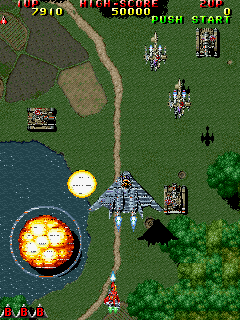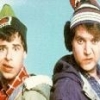Raiden 2, an arcade console game from 1993, probably is not doing that.
It was the era of tiled layered sprites. The ROM size of the original PCB version appears to be around 200KB.
Are these maps really tile-based? Or is it one huge image that just render according to the camera?
Considering the era and the game, maps would certainly be tile based.
The ground continuously scrolls top to bottom, and moves left to right based on the player's position. That works really well for tiles, especially on that era where tile drawing was automatically handled in hardware. It is unlikely they had a giant level-long image of the ground and still managed to fit inside 200KB. It is far easier to point the hardware at a ROM segment, then pass it 8-byte, 12-byte, or 16-byte reference numbers.
I'm sure many of the tiles were made by breaking up large artwork. An artist may have drawn a tree and then used a tool to build a 2x3 block of sprite indexes. Most of the map segments, things like roads and coastlines and water and grass and fields and building tops, were likely all built from tiles and composed by hand in tools.
Look at the images and you'll note there are only two or three different angle for most of things. Many of the tile engines of the day included a pair of flip bits, flip horizontal and flip vertical, and many included rotate bits, rotate 1/4 turn 0-3 times. The four bits allowed a single sprite to potentially have 16 different variants. Most of the ground tiles on the game appear to be rotated and flipped in many different layouts.
The game has been ported to many different systems. I don't see the images on Google, but I imagine a few of those ports have image sheets that contain all the image tiles and sprites.









